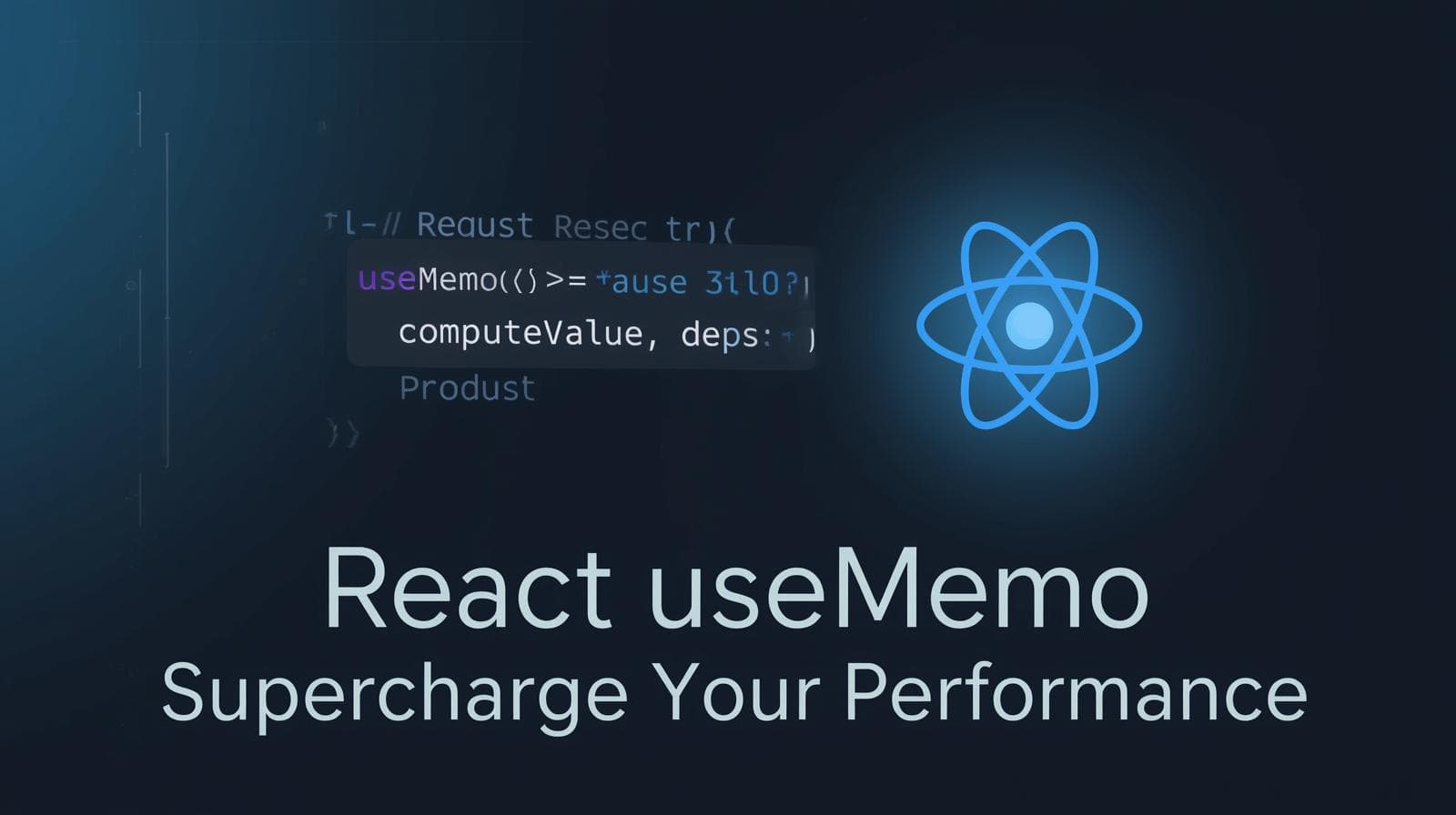Master the React useRef Hook: An In-Depth Guide with Examples & Use Cases

Confused by React's useRef? This definitive guide explains what useRef is, how it works, and its real-world use cases like accessing DOM elements, managing focus, and storing mutable values without re-renders. Perfect for React beginners and pros.

Master the React useRef Hook: An In-Depth Guide with Examples & Use Cases
Taming the DOM and Beyond: Your Definitive Guide to the React useRef Hook
You’ve built your first few React components. You’re comfortable with useState for managing data and useEffect for handling side effects. You’re feeling good! But then, you stumble upon a task that feels... different. You need to focus an input field when a button is clicked. Or maybe you need to track how many times a component has rendered without causing a re-render yourself. Or perhaps you need to directly interact with a video player.
This is where you meet the useRef Hook. At first glance, it can seem a bit mysterious, even intimidating. It doesn't cause re-renders like useState, so its effects are silent. But once you understand its purpose, it becomes an indispensable tool in your React toolkit.
In this comprehensive guide, we’re going to demystify useRef. We’ll break down what it is, how it works, and walk through real-world scenarios where it shines. Let’s dive in.
What is the useRef Hook, Really?
In simple terms, useRef is a built-in React Hook that returns a mutable (changeable) object whose .current property is initialized to the passed argument. This object persists for the full lifetime of the component.
Let's look at its basic syntax:
javascript
import { useRef } from 'react';
function MyComponent() {
const myRef = useRef(initialValue);
// Access the value via myRef.current
console.log(myRef.current); // logs the initialValue
// You can update the value
myRef.current = newValue;
// ... rest of your component logic
}The key thing to remember is this: Mutating the .current property does not cause a re-render. This is the fundamental difference from the useState Hook.
The ref Object: A Box for Your Value
Think of useRef as a magic box. You can put anything you want inside this box via the .current property. It could be a number, a string, a DOM element, or even a complex object. Once it's in the box, it stays there until you explicitly take it out or replace it, and no matter how many times your component re-renders, the box remains the same.
useRef vs. useState: Knowing When to Use Which
This is a common point of confusion. Let's clear it up.
Feature |
|
|
|---|---|---|
Triggers Re-render | ❌ No | ✅ Yes |
Mutable Value | ✅ Yes (via | ❌ No (use setter function) |
Synchronous Updates | ✅ Yes (updates are immediate) | ❌ No (updates are asynchronous) |
Use Case | Storing mutable data that doesn't need to be displayed, or for direct DOM access. | Storing data that, when changed, should be reflected in the UI. |
The Golden Rule: If a piece of data is used in your JSX to render something, it must be state. If you’re just "keeping track" of something in the background that doesn't affect the visual output, useRef is likely a better fit.
Real-World Use Cases for useRef (With Code Examples)
Theory is great, but useRef truly makes sense when you see it in action. Here are the most common scenarios.
1. Directly Accessing DOM Elements
This is the most frequent use case. You need to imperatively interact with a native DOM element.
Example: Focusing an Input Field
Imagine a search form where you want the input to be focused as soon as the page loads.
jsx
import { useRef, useEffect } from 'react';
function SearchForm() {
// 1. Create a ref
const searchInputRef = useRef(null);
useEffect(() => {
// 3. Access the DOM element after the component mounts
if (searchInputRef.current) {
searchInputRef.current.focus();
}
}, []); // Empty dependency array means this runs once on mount
return (
<form>
{/* 2. Attach the ref to the JSX element */}
<input
type="text"
placeholder="Search..."
ref={searchInputRef}
/>
<button type="submit">Search</button>
</form>
);
}How it works:
We create a ref using
useRef(null). Initially, it's an empty box.We assign this ref to the
refattribute of the<input>JSX element. React automatically setssearchInputRef.currentto be that actual DOM input node.In a
useEffect(which runs after the component renders), we check if the ref has a value and then call the native.focus()method on it.
2. Storing Mutable Values That Don't Trigger Re-renders
Sometimes you need to keep track of something, but showing it on the screen isn't necessary.
Example: Tracking Previous State or Prop Values
jsx
import { useRef, useEffect, useState } from 'react';
function Counter() {
const [count, setCount] = useState(0);
// We use a ref to track the previous value
const prevCountRef = useRef();
useEffect(() => {
// Update the ref with the current count *after* the render is committed
prevCountRef.current = count;
}); // No dependency array: this runs after every render
const prevCount = prevCountRef.current;
return (
<div>
<h1>Now: {count}, Before: {prevCount}</h1>
<button onClick={() => setCount(count + 1)}>Increment</button>
</div>
);
}In this example, prevCountRef silently stores the value of count from the previous render. Updating the ref in the useEffect doesn't cause a re-render, preventing an infinite loop.
Example: Keeping Track of a Timer ID
This is crucial for cleanup.
jsx
function TimerComponent() {
const [seconds, setSeconds] = useState(0);
const intervalRef = useRef(null);
const startTimer = () => {
intervalRef.current = setInterval(() => {
setSeconds(prevSeconds => prevSeconds + 1);
}, 1000);
};
const stopTimer = () => {
// We clear the interval using the ID stored in the ref
clearInterval(intervalRef.current);
};
useEffect(() => {
// Cleanup on component unmount
return () => clearInterval(intervalRef.current);
}, []);
return (
<div>
<p>Seconds: {seconds}</p>
<button onClick={startTimer}>Start</button>
<button onClick={stopTimer}>Stop</button>
</div>
);
}If we used a state variable for the interval ID, changing it would cause an unnecessary re-render. The ref is the perfect tool for this job.
3. Working with Third-Party Libraries
Many non-React libraries (e.g., D3.js, Chart.js, or animation libraries) require a direct reference to a DOM element to work their magic.
jsx
import { useRef, useEffect } from 'react';
import { initCustomChart } from 'some-chart-library'; // Hypothetical library
function ChartComponent({ data }) {
const chartContainerRef = useRef(null);
const chartInstanceRef = useRef(null); // Also store the chart instance
useEffect(() => {
if (chartContainerRef.current) {
// Pass the DOM element to the third-party library
chartInstanceRef.current = initCustomChart(chartContainerRef.current, data);
}
// Cleanup: destroy the chart when the component unmounts
return () => {
if (chartInstanceRef.current) {
chartInstanceRef.current.destroy();
}
};
}, [data]); // Re-initialize if data changes
return <div ref={chartContainerRef} />;
}Best Practices and Common Pitfalls
Don't Overuse Refs: Your first instinct should be to use state and props. Refs are an "escape hatch." Use them sparingly.
Never Modify a Ref During Rendering: Write to refs inside event handlers or effects, not during the render itself. Reading during render is also conditional and can make your component impure.
jsx
// ❌ Don't do this function MyComponent() { const myRef = useRef(0); myRef.current = 123; // Modifying during render return <div>...</div>; } // ✅ Do this instead function MyComponent() { const myRef = useRef(0); useEffect(() => { myRef.current = 123; // Modifying in an effect }); const handleClick = () => { myRef.current = 456; // Modifying in an event handler }; return <div>...</div>; }ref.currentcan benull: Always check ifref.currentexists before using it, especially when accessing it for the first time or after conditional rendering.
Frequently Asked Questions (FAQs)
Q: Can I use useRef instead of useState for everything?
A: Technically, you could, but you shouldn't. Your UI would never update because changing a ref doesn't trigger a re-render. This would lead to broken and inconsistent components.
Q: How is useRef different from creating a variable outside the component?
A: A variable outside the component (e.g., let myVar = 0;) is shared across all instances of your component. A useRef value is local to each component instance. If you render MyComponent five times, each will have its own separate ref.
Q: When is ref.current set? Can I use it immediately?
A: For DOM refs, React sets .current after the component has mounted and the DOM has been updated. This is why you should access DOM refs inside a useEffect or an event handler, not during the initial render.
Conclusion
The useRef Hook is a powerful and specific tool in the React ecosystem. It's not a replacement for useState but a companion that handles the imperative, "behind-the-scenes" work in your applications. By mastering useRef, you gain the ability to interact directly with the DOM, persist values across renders without side effects, and integrate with a wider world of JavaScript libraries.
Remember, with great power comes great responsibility. Use refs wisely for the tasks they are meant for, and your React components will be more robust, efficient, and powerful.
Ready to master React and other in-demand technologies? This deep dive into useRef is just a taste of the practical, project-based learning we offer. To learn professional software development courses such as Python Programming, Full Stack Development, and the MERN Stack, visit and enroll today at codercrafter.in. Build the skills to launch your tech career









